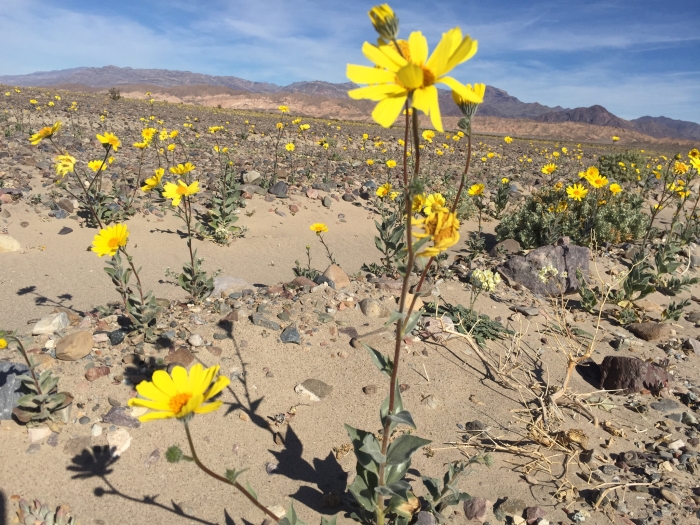Desert Sunflower
(Geraea canescens)
Desert Sunflower (Geraea canescens)
/
/

Nelson Balcar
CC BY 4.0
Image By:
Nelson Balcar
Recorded By:
Copyright:
CC BY 4.0
Copyright Notice:
Photo by: Nelson Balcar | License Type: CC BY 4.0 | License URL: http://creativecommons.org/licenses/by/4.0/ | Rights Holder: Nelson Balcar | Publisher: iNaturalist | Date Created: 2016-02-11T18:29:51Z |

























Estimated Native Range
Summary
Geraea canescens, commonly known as Desert Sunflower, is an annual herb that is native to the arid desert regions of western North America, including Arizona, Nevada, California, and Utah. It is specifically adapted to the conditions of the California, Mojave, and Sonoran Deserts, flourishing in sandy soils at elevations from below sea level up to 3707 feet (1130 meters). This plant typically reaches a height of 1-3 feet and is characterized by its hairy, gray-green foliage and branching habit.
Desert Sunflower is celebrated for its vibrant yellow, daisy-like flowers which bloom from February through May, with a possible secondary bloom in October and November. The flowers are highly attractive to pollinators such as bees and also provide a food source for birds and rodents. In cultivation, it is valued for its drought tolerance and ability to thrive in poor, sandy soils, making it a suitable choice for xeriscaping and naturalistic desert gardens. It requires full sun exposure and minimal water once established, embodying the quintessential desert plant. While it is not commonly afflicted by diseases, its rapid growth and seeding can make it somewhat aggressive in garden settings.CC BY-SA 4.0
Desert Sunflower is celebrated for its vibrant yellow, daisy-like flowers which bloom from February through May, with a possible secondary bloom in October and November. The flowers are highly attractive to pollinators such as bees and also provide a food source for birds and rodents. In cultivation, it is valued for its drought tolerance and ability to thrive in poor, sandy soils, making it a suitable choice for xeriscaping and naturalistic desert gardens. It requires full sun exposure and minimal water once established, embodying the quintessential desert plant. While it is not commonly afflicted by diseases, its rapid growth and seeding can make it somewhat aggressive in garden settings.CC BY-SA 4.0
Plant Description
- Plant Type: Herb
- Height: 1-3 feet
- Width: 1-2 feet
- Growth Rate: Rapid
- Flower Color: Yellow
- Flowering Season: Spring, Summer, Fall
- Leaf Retention: Deciduous
Growth Requirements
- Sun: Full Sun
- Water: Medium
- Drainage: Medium
Common Uses
Drought Tolerant, Erosion Control, Low Maintenance
Natural Habitat
Native to the arid desert regions of the California, Mojave, and Sonoran Deserts
Other Names
Common Names: Desert Sunflower, Desert Gold
Scientific Names: , Geraea canescens, Encelia eriocephala, Encelia eriocephala var. eriocephala, Encelia eriocephala var. paniculata, Geraea canescens var. paniculata, Simsia canescens,
GBIF Accepted Name: